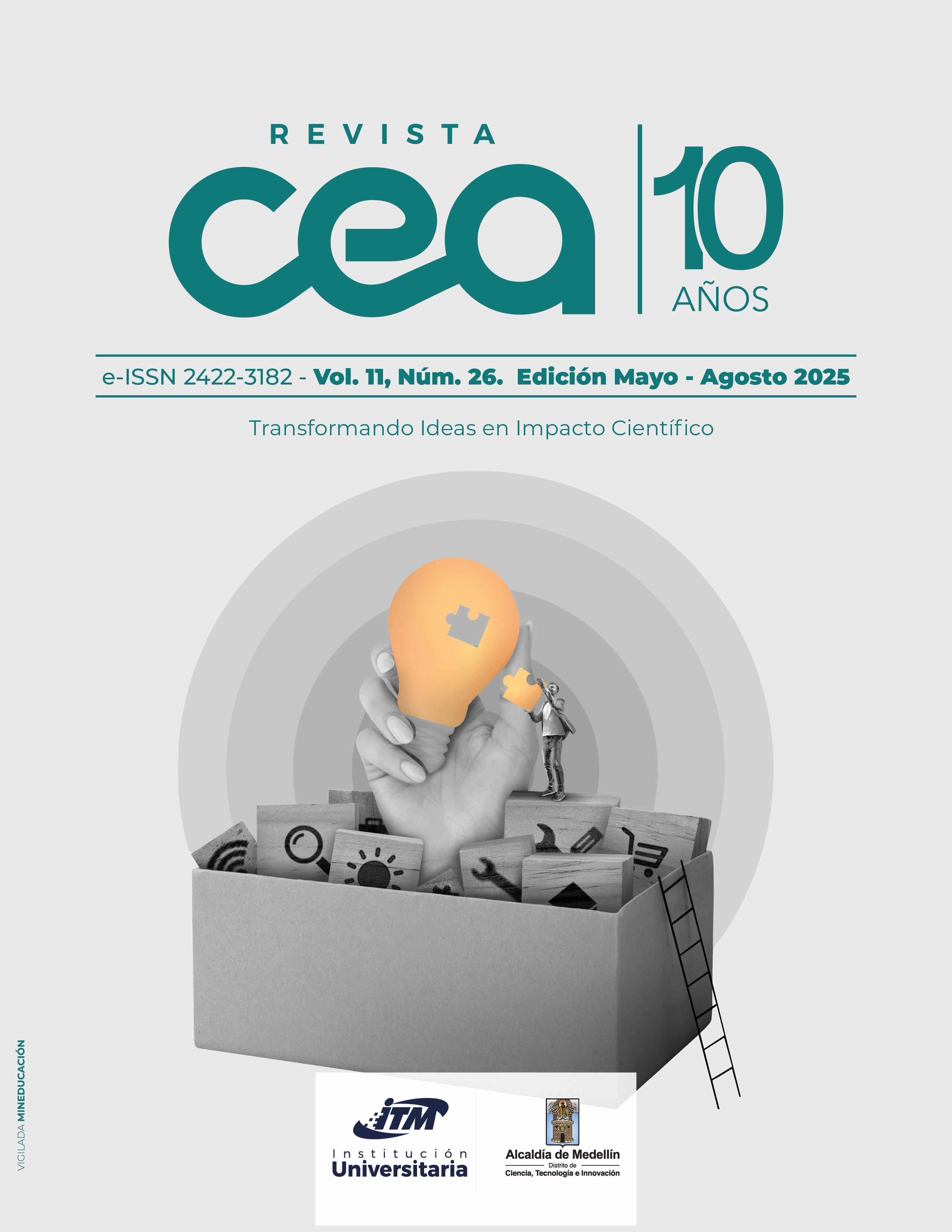Capacidades de innovación en el sector público: una revisión sistemática de literatura
Resumen
Objetivo: la presente revisión de literatura tuvo como objetivo analizar cómo se ha abordado el estudio de las capacidades de innovación en el sector público desde el punto de vista de la definición conceptual, los métodos de medición y la agenda para futuras investigaciones.
Diseño/Metodología: la investigación empleó un enfoque cualitativo de alcance descriptivo. Específicamente, se acudió al método Prisma, con el cual se identificaron 56 documentos que fueron revisados a profundidad.
Resultados: Se evidenció que la medición de las capacidades de innovación aún carece de acuerdos que permitan trabajar con variables unificadas, que guíen el diseño de métricas para desarrollar ejercicios de diagnóstico y puesta en marcha de planes para mejorar los procesos de innovación. Las escalas han privilegiado la adopción de métricas propias del sector privado, siendo necesario ajustarlas al contexto del sector público. Por último, la agenda de investigación plantea la necesidad de focalizar cuatro categorías de análisis: crisis y capacidades de innovación, inteligencia colectiva y capacidades de innovación, tecnologías emergentes y capacidades de innovación en el sector público e innovación y capacidades de innovación.
Conclusiones: si bien las capacidades de innovación han sido ampliamente trabajadas en el contexto del sector privado, aún falta por desarrollar más estudios de enfoque cualitativo, cuantitativo y mixto que ayuden a generar una taxonomía clara sobre la temática en el contexto del sector público, más aún cuando el mismo presenta características particulares que difieren notoriamente del privado.
Originalidad: el estudio aporta a la discusión sobre capacidades de innovación en el sector público, mostrando la necesidad de desarrollar trabajos que aboguen por considerar contextos de países emergentes, las particularidades del sector público y la unificación de un modelo general que sirva como referencia para futuros trabajos académicos y empíricos.
Referencias bibliográficas
Adams, R., Bessant, J., y Phelps, R. (2006). Innovation management measurement: A review. International Journal of Management Reviews, 8(1), 21–47. https://doi.org/10.1111/j.1468-2370.2006.00119.x
Agarwal, R., Mittal, N., Patterson, E., y Giorcelli, M. (2021). Evolution of the Indian LPG industry: Exploring conditions for public sector business model innovation. Research Policy, 50(4), 104196. https://doi.org/10.1016/j.respol.2020.104196
Ali, A., Iqbal, S., Haider, S. A., Tehseen, S., Anwar, B., Sohail, M., y Rehman, K. (2021). Does Governance in Information Technology Matter When It Comes to Organizational Performance in Pakistani Public Sector Organizations? Mediating Effect of Innovation. SAGE Open, 11(2). https://doi.org/10.1177/21582440211016557
Al-Noaimi, H. A., Al-Jayyousi, O. R., y Durugbo, C. M. (2021). Between dogma and doubt: A meta-synthesis of innovation in the public sector. Australian Journal of Public Administration, 83, 201-232. https://doi.org/10.1111/1467-8500.12501
AlNuaimi, B. K., y Khan, M. (2019). Public-sector green procurement in the United Arab Emirates: Innovation capability and commitment to change. Journal of Cleaner Production, 233, 482–489. https://doi.org/10.1016/j.jclepro.2019.06.090
Alshanty, A. M., y Emeagwali, O. L. (2019). Market-sensing capability, knowledge creation and innovation: The moderating role of entrepreneurial-orientation. Journal of Innovation and Knowledge, 4(3), 171–178. https://doi.org/10.1016/j.jik.2019.02.002
Ansell, C., Sørensen, E., y Torfing, J. (2020). The COVID-19 pandemic as a game changer for public administration and leadership? The need for robust governance responses to turbulent problems. Public Management Review, 23(7), 949–960. https://doi.org/10.1080/14719037.2020.1820272
Arundel, A., Bloch, C., y Ferguson, B. (2019). Advancing innovation in the public sector: Aligning innovation measurement with policy goals. Research Policy, 48(3), 789–798. https://doi.org/10.1016/j.respol.2018.12.001
Arundel, A., Casali, L., y Hollanders, H. (2015). How European public sector agencies innovate: The use of bottom-up, policy-dependent and knowledge-scanning innovation methods. Research Policy, 44(7), 1271–1282. https://doi.org/10.1016/j.respol.2015.04.007
Barney, J. (1991). Firm Resources and Sustained Competitive Advantage. Journal of Management, 17(1), 99–120. https://doi.org/10.1177/014920639101700108
Barrutia, J. M., Echebarria, C., Aguado-Moralejo, I., Apaolaza-Ibáñez, V., y Hartmann, P. (2022). Leading smart city projects: Government dynamic capabilities and public value creation. Technological Forecasting and Social Change, 179, 121679. https://doi.org/10.1016/j.techfore.2022.121679
Basit, T. N. (2003). Manual or electronic? The role of coding in qualitative data analysis. Educational Research, 45(2), 143–154. https://doi.org/10.1080/0013188032000133548
Bloch, C. (2011). Measuring public innovation in the Nordic countries (MEPIN). Nordic Innovation Centre (NICe) - The Danish Centre for Studies in Research and Research Policy (CFA). http://www.diva-portal.org/smash/get/diva2:707193/FULLTEXT01.pdf
Bryson, J. M., Ackermann, F., y Eden, C. (2007). Putting the Resource-Based View of Strategy and Distinctive Competencies to Work in Public Organizations. Public Administration Review, 67(4), 702–717. https://www.jstor.org/stable/4624619
Carneiro, D. K., Isidro Filho, A., y Criado, J. I. (2023). Public Sector Innovation Ecosystems: A Proposition for Theoretical-Conceptual Integration. International Journal of Public Administration, 47(14), 937–950. https://doi.org/10.1080/01900692.2023.2213853
Chang, W. C., Lin, W. Z., Chen, W. Z., Chiou, W. K., y Lin, O. S. (2025). Design-driven innovation in the public sector: insights from case studies of initiatives in Taiwan. Journal of Asian Public Policy, 1-32. https://doi.org/10.1080/17516234.2025.2457166
Chartered Association of Business Schools. (2021). Academic Journal Guide 2021. ABS. https://charteredabs.org/academic-journal-guide-2021/#how-to-use
Chen, J., Walker, R. M., y Sawhney, M. (2020). Public service innovation: a typology. Public Management Review, 22(11), 1674–1695. https://doi.org/10.1080/14719037.2019.1645874
Clausen, T. H., Demircioglu, M. A., y Alsos, G. A. (2020). Intensity of innovation in public sector organizations: The role of push and pull factors. Public Administration, 98(1), 159–176. https://doi.org/10.1111/padm.12617
Combs, J. P., Bustamante, R. M., y Onwuegbuzie, A. J. (2010). An interactive model for facilitating development of literature reviews. International Journal of Multiple Research Approaches, 4(2), 159–182. https://doi.org/10.5172/mra.2010.4.2.159
Cortes, A. F., y Herrmann, P. (2021). Strategic Leadership of Innovation: A Framework for Future Research. International Journal of Management Reviews, 23(2), 224–243. https://doi.org/10.1111/ijmr.12246
Criado, J. I., Alcaide-Muñoz, L., y Liarte, I. (2023). Two decades of public sector innovation: building an analytical framework from a systematic literature review of types, strategies, conditions, and results. Public Management Review, 27(3), 623-652. https://doi.org/10.1080/14719037.2023.2254310
Damanpour, F., Walker, R. M., y Avellaneda, C. N. (2009). Combinative effects of innovation types and organizational Performance: A longitudinal study of service organizations. Journal of Management Studies, 46(4), 650–675. https://doi.org/10.1111/j.1467-6486.2008.00814.x
De Vries, H., Bekkers, V., y Tummers, L. (2016). Innovation in the public sector: A systematic review and future research agenda. Public Administration, 94(1), 146–166. https://doi.org/10.1111/padm.12209
De Vries, H., Tummers, L., y Bekkers, V. (2018). The Diffusion and Adoption of Public Sector Innovations: A Meta-Synthesis of the Literature. Perspectives on Public Management and Governance, 1(3), 159–176. https://doi.org/10.1093/ppmgov/gvy001
Demircioglu, M. A., y Audretsch, D. B. (2017). Conditions for innovation in public sector organizations. Research Policy, 46(9), 1681–1691. https://doi.org/10.1016/j.respol.2017.08.004
Dodaro, M. (2023). Municipal Entrepreneurship Support Policies: Convergence orDivergence? Local Government Studies, 49(2), 274–293. https://doi.org/10.1080/03003930.2021.1932479
Dockx, E., y Verhoest, K. (2023). Dissecting the organization matters: Gauging the effect of unit-level and organization-level factors on perceived innovation outcomes. Public Policy and Administration, 1–29. https://doi.org/10.1177/09520767231193605
Eisenhardt, K. M., y Martin, J. A. (2000). Dynamic capabilities: What are they? Strategic Management Journal, 21(10–11), 1105–1121. https://doi.org/10.1002/1097-0266(200010/11)21:10/11<1105::AID-SMJ133>3.0.CO;2-E
Feldman, M. S., y Pentland, B. T. (2003). Reconceptualizing organizational routines as a source of flexibility and change. Administrative Science Quarterly, 48(1), 94–118. https://doi.org/10.2307/3556620
Gibbs, G. (2012). El análisis de datos cualitativos en Investigación Cualitativa. Ediciones Morata.
Gieske, H., Van Meerkerk, I., y Van Buuren, A. (2019). The Impact of Innovation and Optimization on Public Sector Performance: Testing the Contribution of Connective, Ambidextrous, and Learning Capabilities. Public Performance and Management Review, 42(2), 432–460. https://doi.org/10.1080/15309576.2018.1470014
Gómez Muñoz, C. F., y Moreno Romero, A. (2021). Organisational Innovation in Bureaucracies: An Impossible Mission? Dirección y Organización, 74, 54-66. https://doi.org/10.37610/dyo.v0i74.602
Grant, R. M. (1991). The Resource-Based Theory of Competitive Advantage: Implications for Strategy Formulation. California Management Review, 33(3), 114–135. https://doi.org/10.2307/41166664
Gullmark, P. (2021). Do All Roads Lead to Innovativeness? A Study of Public Sector Organizations’ Innovation Capabilities. American Review of Public Administration, 51(7), 509–525. https://doi.org/10.1177/02750740211010464
Gullmark, P., y Clausen, T. H. (2023). In search of innovation capability and its sources in local government organizations: a critical interpretative synthesis of the literature. International Public Management Journal, 26(2), 258–280. https://doi.org/10.1080/10967494.2022.2157917
Hair, J. F., Risher, J. J., Sarstedt, M., y Ringle, C. M. (2019). When to use and how to report the results of PLS-SEM. European Business Review, 31(1), 2–24. https://doi.org/10.1108/EBR-11-2018-0203
Hall, J. L. (2007). Informing State Economic Development Policy in the New Economy: A Theoretical Foundation and Empirical Examination of State Innovation in the United States. Public Administration Review, 67(4), 630–645. https://doi.org/10.1111/j.1540-6210.2007.00749.x
Hartley, J., Sørensen, E., y Torfing, J. (2013). Collaborative Innovation: A Viable Alternative to Market Competition and Organizational Entrepreneurship. Public Administration Review, 73(6), 821–830. https://doi.org/10.1111/puar.12136
Hiebl, M. R. W. (2021). Sample Selection in Systematic Literature Reviews of Management Research. Organizational Research Methods, 26(2), 229–261. https://doi.org/10.1177/1094428120986851
Huynh, T. N., Van Nguyen, P., Do, A. M., Dinh, P. U., y Vo, H. T. (2024). Fostering organizational performance through innovation: The roles of environmental policy instruments, organizational learning supports, and intellectual capital. Heliyon, 10(20), e39361. https://doi.org/10.1016/j.heliyon.2024.e39361
Janssen, S., Moeller, K., y Schlaefke, M. (2011). Using performance measures conceptually in innovation control. Journal of Management Control, 22(1), 107–128. https://doi.org/10.1007/s00187-011-0130-y
Jegerson, D., Jabeen, F., Abdulla, H. H., Putrevu, J., y Streimikiene, D. (2024). Does emotional intelligence impact service innovation capabilities? Exploring the role of diversity climate and innovation culture. Journal of Intellectual Capital, 25(1), 166–187. https://doi.org/10.1108/JIC-11-2022-0235
Jørgensen, T. B., y Bozeman, B. (2007). Public values: An inventory. Administration and Society, 39(3), 354–381. https://doi.org/10.1177/0095399707300703
Jurado-Zambrano, D. A., y Echeverrri Hoyos, I. C. (2024). Dinamizando la gestión del conocimiento a través de mapas de conocimiento: un análisis desde los beneficios y las dificultades. Revista CEA, 10(24), e2763. https://doi.org/10.22430/24223182.2763
Kattel, R., y Mazzucato, M. (2018). Mission-oriented innovation policy and dynamic capabilities in the public sector. Industrial and Corporate Change, 27(5), 787–801. https://doi.org/10.1093/icc/dty032
Klein, P. G., Mahoney, J. T., Mcgahan, A. M., y Pitelis, C. N. (2013). Capabilities and Strategic Entrepreneurship in Public Organizations. Strategic Entrepreneurship Journal, 7(1), 70–91. https://doi.org/10.1002/sej.1147
Lægreid, P., Roness, P. G., y Verhoest, K. (2011). Explaining the Innovative Culture and Activities of State Agencies. Organization Studies, 32(10), 1321–1347. https://doi.org/10.1177/0170840611416744
Lambert, F. (2013). Seeking electronic information from government resources: A comparative analysis of two communities’ web searching of municipal government websites. Government Information Quarterly, 30(1), 99–109. https://doi.org/10.1016/j.giq.2012.07.007
Lapuente, V., y Suzuki, K. (2020). Politicization, Bureaucratic Legalism, and Innovative Attitudes in the Public Sector. Public Administration Review, 80(3), 454–467. https://doi.org/10.1111/puar.13175
Lewis, J. M., Ricard, L. M., y Klijn, E. H. (2017). How innovation drivers, networking and leadership shape public sector innovation capacity. International Review of Administrative Sciences, 84(2), 288–307. https://doi.org/10.1177/0020852317694085
Liarte, I., Criado, J. I., y Alcaide-muñoz, L. (2025). Determinants of Public Sector Innovation: A Comparative Study of Spanish Local Governments. International Journal of Public Administration, 1–16. https://doi.org/10.1080/01900692.2025.2451390
Liberati, A., Altman, D. G., Tetzlaff, J., Mulrow, C., Gøtzsche, P. C., Ioannidis, J. P. A., Clarke, M., Devereaux, P. J., Kleijnen, J., y Moher, D. (2009). The PRISMA statement for reporting systematic reviews and meta-analyses of studies that evaluate healthcare interventions: explanation and elaboration. BMJ, 339. https://doi.org/10.1136/bmj.b2700
Lidman, L. (2024). The Gap Between the Rhetorical Why and the Practical What and How of Public Sector Innovation. International Journal of Public Administration, 47(11), 748–758. https://doi.org/10.1080/01900692.2023.2197175
Meijer, A. (2018). Public Innovation Capacity: Developing and Testing a Self-Assessment Survey Instrument. International Journal of Public Administration, 42(8), 617–627. https://doi.org/10.1080/01900692.2018.1498102
Moon, M. J., y Norris, D. F. (2005). Does managerial orientation matter? the adoption of reinventing government and e-government at the municipal level. Information Systems Journal, 15(1), 43–60. https://doi.org/10.1111/j.1365-2575.2005.00185.x
Moore, M. H. (1995). Creating public value: Strategic management in government. Harvard University Press. https://www.hup.harvard.edu/books/9780674175587
Moussa, M., McMurray, A., y Muenjohn, N. (2018). Innovation in public sector organisations. Cogent Business & Management, 5(1), 1475047. https://doi.org/10.1080/23311975.2018.1475047
O’Toole, L. J. (1997). Implementing public innovations in network settings. Administration and Society, 29(2), 115–138. https://doi.org/10.1177/009539979702900201
Organización de Cooperación y Desarrollo Económicos y Oficina de Estadísticas de las Comunidades Europeas. (2005). Manual de Oslo: Guía para la recogida e interpretación de datos sobre innovación (3ª ed.). Tragsa. https://doi.org/10.1787/9789264065659-es
Osborne, S. P., y Brown, L. (2011). Innovation, public policy and public services delivery in the UK. The word that would be king? Public Administration, 89(4), 1335–1350. https://doi.org/10.1111/j.1467-9299.2011.01932.x
Pablo, A. L., Reay, T., Dewald, J. R., y Casebeer, A. L. (2007). Identifying, enabling and managing dynamic capabilities in the public sector. Journal of Management Studies, 44(5), 687–708. https://doi.org/10.1111/j.1467-6486.2006.00675.x
Page, M. J., McKenzie, J. E., Bossuyt, P. M., Boutron, I., Hoffmann, T. C., Mulrow, C. D., Shamseer, L., Tetzlaff, J. M., Akl, E. A., Brennan, S. E., Chou, R., Glanville, J., Grimshaw, J. M., Hróbjartsson, A., Lalu, M. M., Li, T., Loder, E. W., Mayo-Wilson, E., McDonald, S., … Moher, D. (2021). The PRISMA 2020 statement: An updated guideline for reporting systematic reviews. The BMJ, 372. https://doi.org/10.1136/bmj.n71
Pang, M. S., Lee, G., y Delone, W. H. (2014). IT resources, organizational capabilities, and value creation in public-sector organizations: a public-value management perspective. Journal of Information Technology, 29(3), 187–205. https://doi.org/10.1057/jit.2014.2
Paskaleva, K., y Cooper, I. (2018). Open innovation and the evaluation of internet-enabled public services in smart cities. Technovation, 78, 4–14. https://doi.org/10.1016/j.technovation.2018.07.003
Paul, J., y Rialp Criado, A. (2020). The art of writing literature review: What do we know and what do we need to know? International Business Review, 29(4), 101717. https://doi.org/10.1016/j.ibusrev.2020.101717
Piening, E. P. (2011). Insights into the Process Dynamics of Innovation Implementation: The case of public hospitals in Germany. Public Management Review, 13(1), 127–157. https://doi.org/10.1080/14719037.2010.501615
Piening, E. P. (2013). Dynamic Capabilities in Public Organizations: A literature review and research agenda. Public Management Review, 15(2), 209–245. https://doi.org/10.1080/14719037.2012.708358
Pučėtaitė, R., Novelskaitė, A., Lämsä, A. M., y Riivari, E. (2016). The Relationship Between Ethical Organisational Culture and Organisational Innovativeness: Comparison of Findings from Finland and Lithuania. Journal of Business Ethics, 139(4), 685–700. https://doi.org/10.1007/s10551-016-3051-8
Renard, L., y St-Amant, G. E. (2003). Capacité, capacité organisationnelle et capacité dynamique : une proposition de définitions. Les Cahiers Du Management Technologique, 13(1). http://www.sietmanagement.fr/wp-content/uploads/2018/02/RenardStAmant2003.pdf
Ricard, L. M., Klijn, E. H., Lewis, J. M., y Ysa, T. (2017). Assessing public leadership styles for innovation: a comparison of Copenhagen, Rotterdam and Barcelona. Public Management Review, 19(2), 134–156. https://doi.org/10.1080/14719037.2016.1148192
Robledo, J., López, C., Zapata, W., y Pérez, J. D. (2010). Desarrollo de una Metodología de Evaluación de Capacidades de Innovación. Perfil de Coyuntura Económica, 15, 133–148. https://www.redalyc.org/articulo.oa?id=86120154007
Schilke, O., Hu, S., y Helfat, C. E. (2018). Quo vadis, dynamic capabilities? A content-analytic review of the current state of knowledge and recommendations for future research. Academy of Management Annals, 12(1), 390–439. https://doi.org/10.5465/annals.2016.0014
Shahzad, M. K., Ahmed, S., Anwar, F., y Hussain, T. (2024). Achieving competitiveness through innovation capability: developing what public sector customers really need. Measuring Business Excellence, 28(3/4), 415–425. https://doi.org/10.1108/MBE-04-2024-0052
Software Engineering Group School of Computer Science and Mathematics Keele University y Department of Computer Science University of Durham. (2007). Guidelines for performing Systematic Literature Reviews in Software Engineering Version 2.3. EBSE Technical Report EBSE-2007-01. https://www.elsevier.com/__data/promis_misc/525444systematicreviewsguide.pdf
Sørensen, E., y Torfing, J. (2019). Designing institutional platforms and arenas for interactive political leadership. Public Management Review, 21(10), 1443–1463. https://doi.org/10.1080/14719037.2018.1559342
Staples, M., y Niazi, M. (2007). Experiences using systematic review guidelines. Journal of Systems and Software, 80(9), 1425–1437. https://doi.org/10.1016/j.jss.2006.09.046
Teece, D. J. (2016). Dynamic capabilities and entrepreneurial management in large organizations: Toward a theory of the (entrepreneurial) firm. European Economic Review, 86, 202–216. https://doi.org/10.1016/j.euroecorev.2015.11.006
Teece, D. J., Pisano, G., y Shuen, A. (1997). Dynamic capabilities and strategic management. Strategic Management Journal, 18(7), 509–533. https://doi.org/10.1002/(SICI)1097-0266(199708)18:7<509::AID-SMJ882>3.0.CO;2-Z
Tolbert, C. J., Mossberger, K., y Mcneal, R. (2008). Institutions, Policy Innovation, and E-Government in the American States. Public Administration Review, 68(3), 549–563. https://doi.org/10.1111/j.1540-6210.2008.00890.x
Torfing, J. (2019). Collaborative innovation in the public sector: the argument. Public Management Review, 21(1), 1–11. https://doi.org/10.1080/14719037.2018.1430248
Torvinen, H., y Jansson, K. (2023). Public health care innovation lab tackling the barriers of public sector innovation. Public Management Review, 25(8), 1539–1561. https://doi.org/10.1080/14719037.2022.2029107
Trivellato, B., Martini, M., y Cavenago, D. (2020). How Do Organizational Capabilities Sustain Continuous Innovation in a Public Setting? American Review of Public Administration, 51(1), 57–71. https://doi.org/10.1177/0275074020939263
Tsai, W., y Ghoshal, S. (1998). Social capital and value creation: The role of intrafirm networks. Academy of Management Journal, 41(4), 464–476. https://doi.org/10.2307/257085
Velsberg, O., Westergren, U. H., y Jonsson, K. (2020). Exploring smartness in public sector innovation - creating smart public services with the Internet of Things. European Journal of Information Systems, 29(4), 350–368. https://doi.org/10.1080/0960085X.2020.1761272
Yam, R. C. M., Guan, J. C., Pun, K. F., y Tang, E. P. Y. (2004). An audit of technological innovation capabilities in Chinese firms: Some empirical findings in Beijing, China. Research Policy, 33(8), 1123–1140. https://doi.org/10.1016/j.respol.2004.05.004
Yin, R. K. (2018). Case study research and applications: Design and methods (6a ed.). SAGE. https://us.sagepub.com/en-us/nam/case-study-research-and-applications/book250150
Zahra, S. A., y George, G. (2002). Absorptive Capacity: A Review, Reconceptualization, and Extension. The Academy of Management Review, 27(2), 185-203. https://www.jstor.org/stable/4134351
Zambrano-Gutiérrez, J. C., y Puppim de Oliveira, J. A. (2022). The Dynamics of Sources of Knowledge on the Nature of Innovation in the Public Sector: Understanding Incremental and Transformative Innovations in Local Governments. Journal of Public Administration Research and Theory, 32(4), 656–670. https://doi.org/10.1093/jopart/muab053
Descargas
Derechos de autor 2025 Diego Armando Jurado-Zambrano, Sergio Alberto Chica-Vélez

Esta obra está bajo una licencia internacional Creative Commons Atribución-NoComercial-CompartirIgual 4.0.

| Estadísticas de artículo | |
|---|---|
| Vistas de resúmenes | |
| Vistas de PDF | |
| Descargas de PDF | |
| Vistas de HTML | |
| Otras vistas | |







